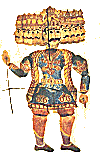The Puppeteers of India
by Dr. K. L. Kamat
First Online: March 23, 2000
Last Updated: December 07, 2024
For centuries, the puppetry in one form or other flourished in India, particularly in the villages. Since ages, it has been an important part of folk culture. The major types of puppetry that are practiced in different Indian states are: rod, string, shadow and glove puppetry is practiced by the tribals from Malabar in Kerala and Tamilnadu. The puppetry is very popular in Orissa, Kerala, Andhra Pradesh and Karnataka. Sometimes the puppets are made with leather and the movements controlled by stick and many times, they are made with wood or cloth, with the movements controlled by strings. The string puppetry is prevalent in Karnataka and Rajasthan. The puppets employed are very small in dimensions. They have a large head with prominent eyes which gives them personality and charm. The body, including the hands, is made of cloth stuffed with rags. Most of them have no legs, but have long, trailing skirts or robes. Only special puppets such as a stunt horse rider has legs. The string attached to the puppet's head goes over the operator's hands and fingers and then into back of the puppet below the waist. Each hand is also controlled through separate strings. The color and features of the faces depend upon the character of the puppets. Goggle-eyed, dark colored puppet represents a wicked person. A royal person has a lighter color and has mustaches. Brocaded cloth decorations and borers add to their beauty. The male wear turbans and females have combed and braided hair. The female figures hold their skirts or sarees in their hands while dancing and put up a lively show, moving quickly and gesturing. The male excel in fighting; they dash against each other strike, chase, grapple and fall dead. These puppets represents, the good versus the bad, victor against vanquished, the hero and the coward, the generous and miserly.
© K. L. Kamat

String Puppets from Rajasthan
A puppeteer family manages its own show. It has a little, mobile convertible state, which consists of a cloth backdrop and a curtain gaily decorated in cut and patch work or hand-printed cloth. The puppets are carved from a variety of local woods. If the quality of wood used is not up to the mark, then white cloth is pasted on it and then are applied natural colors. The lighting comes from two oil lamps, one each at side of the stage. Though this is very insufficient light, it helps the performance by creating eerie atmosphere and hiding the strings. The themes presented are based on the Ramayana and the Mahabharata. The manipulations are carried over by the male members of the troupe. The music, singing, dialogue and narrations are provided by the female members of the family. The youngsters provide music by the way of continuous squeaking, playing mrudangum and cymbal. When cleverly employed these instruments provide puppet like pitches. Situations are created so that different characters may engage in lively, dramatic feats. A court scene is usually the opportunity to bring these stock characters to the stage. The court dancer the stunt horse rider, the drummer and the snake charmers invoke greater interest. The puppetry requires exaggeration and distortion in order to achieve maximum impact. But the limitation of the puppets, the mask which can caricature only a certain number of emotions, emphasizes the satire. In creative manipulation and imitative interplay of the puppets, according to the free range of fantasy, there is room for refined humor. Thus success of any puppet show mainly depends on the genius of the puppeteer. The puppetry in one form or other flourished as an intimate part of ancient Indian life, particularly in the villages, where the puppeteer would have been an important part of folk culture. However due to the influence of electronic entertainment media, an ancient art has had to suffer from lack of patronage and face extinction.
![]()
See Also:
- Kamat Goes to a Puppet Show
- Leather Puppets of India
- Leather Puppets Screen Saver
- Pictures of Puppets of India
- The Puppets of India
![]()

